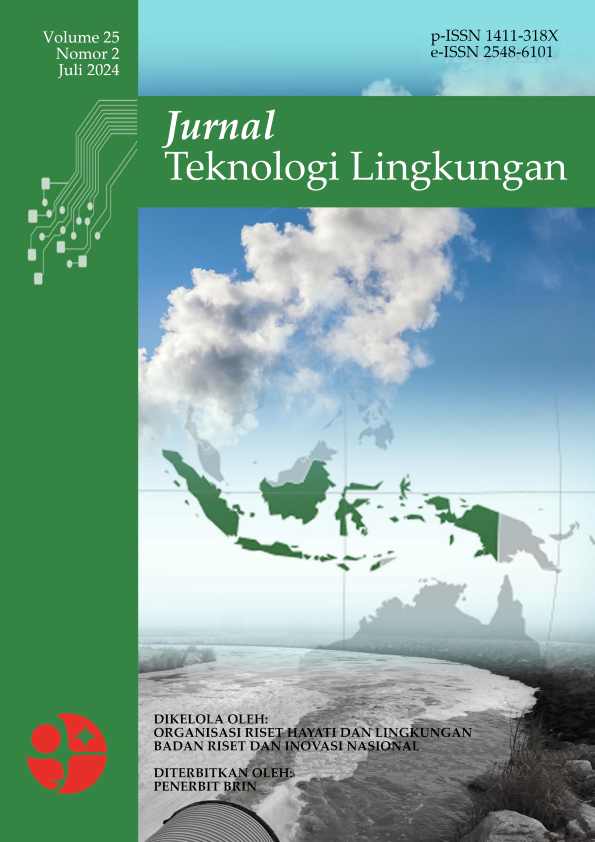Karakterisasi Lindi dan Reformulasi Proses Kimia IPAL Lindi Pembangkit Listrik Tenaga Sampah Bantargebang Bekasi dengan Menggunakan Metode Jar Test
Main Article Content
Abstract
Abstract
The Bantargebang Bekasi Waste Power Plant, as a result of the National Strategic Project, has been operating since 2019. The Plant has a leachate wastewater treatment plant, which is not yet optimal for processing leachate because the COD concentration is still high. The evaluation results showed the need for the characterization of leachate in different weather conditions and formulation changes in the coagulation-flocculation chemical processing system. Combined time samples were taken over a period of time during the rainy and dry seasons to determine the leachate cahaacteristics at the same sampling point, while grab samples were taken to measure temperature and pH. Laboratory analysis methods were carried out in accordance with the national standard and applicable laboratory accreditation in the leachate quality standard parameters of the Minister of Environment and Forestry Regulation No. 59 of 2016. Reformulation in flocculation coagulation chemical processing units uses the jar test method. The results of leachate characterization showed that COD parameters of leachate differ significantly between dry and rainy season conditions. In the dry season, leachate COD reached 19,883 mg/L, while in the rainy season it reached 7,605 mg/L. The design of the WWTP was carried out by improving the chemical processing unit process, including the types of coagulants and flocculants used. Jar test results showed that the choice of flocculant coagulant PACG30-FUH and PAC20-FUHM worked most effectively in terms of process, so it was necessary to change the chemicals used for the chemical processes in WWTP of the Bantargebang Waste Power Plant.
Abstrak
Pembangkit Listrik Tenaga Sampah (PLTSa) Bantargebang Bekasi sebagai hasil Proyek Strategis Nasional (PSN) sudah beroperasi sejak tahun 2019. PLTSa memiliki instalasi pengolahan air limbah lindi yang belum optimal dalam mengolah lindi karena konsentrasi COD yang masih tinggi. Hasil evaluasi menunjukkan perlu adanya karakterisasi lindi pada kondisi cuaca yang berbeda dan perubahan formulasi pada sistem pengolahan kimia koagulasi flokulasi menggunakan bahan kimia yang tepat. Sampel gabungan waktu diambil dalam rentang waktu sesuai dengan perubahan musim hujan dan kemarau untuk mengetahui karakteristik lindi dan pada titik tempat pengambilan sampel yang sama sedangkan sampel sesaat (grab sample) dilakukan untuk pengukuran suhu dan pH. Metode analisis laboratorium dilakukan sesuai dengan standar SNI dan sesuai akreditasi laboratorium yang berlaku pada parameter baku mutu lindi PermenLHK No. 59 Tahun 2016. Untuk reformulasi pada unit pengolahan kimia koagulasi flokulasi menggunakan metode jar test. Hasil karakterisasi lindi menunjukkan adanya perbedaan parameter COD yang signifikan antara lindi pada kondisi musim kemarau dan musim penghujan. Pada musim kemarau COD lindi mencapai angka 19.883 mg/L sedangkan di musim penghujan mencapai 7.605 mg/L. Perancangan IPAL dilakukan dengan perbaikan proses unit pengolahan secara kimia meliputi jenis koagulan dan flokulan yang dipakai. hasil jar test dengan membandingkan koagulan flokulan yang ada, pemilihan bahan kimia koagulan flokulan PACG30-FUH dan PAC20-FUHM bekerja paling efektif dari segi proses, sehingga perlu adanya perubahan bahan kimia yang digunakan untuk proses kimia yang ada dalam IPAL PLTSa Bantargebang.
Article Details

This work is licensed under a Creative Commons Attribution-ShareAlike 4.0 International License.

